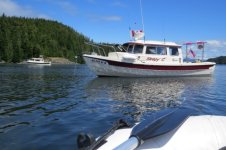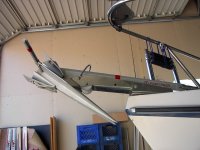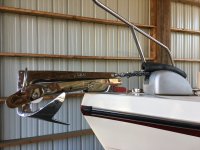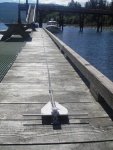I'm updating my anchor roller (Lewmar pivoting) in advance of installing a Windlass (Lewmar V700 Horizontal on order) and encountered the following issues when placing it consistent with the original (Windline non-pivoting) version:
1: When placing the anchor roller to in the same location as the original, it can only pivot a short distance before hitting the front of the bow as shown in the following photo:

2: If I position the roller forward far enough to allow a full range of the pivot without impacting the bow, it's too far forward - the forward bolt hole will not go through to the anchor locker.

I elevated the anchor roller with a scrap of 1-inch starboard, which looks as if it may work to ensure all the mounting bolts are accessible from the anchor locker and allow full movement of the pivoting section as shown here:

What concerns/considerations should I entertain with this approach?
I assume I may need to elevate the windlass the same amount to ensure the rode remains "level" per Lewmar's installation instructions.
Perhaps I'll get a single piece of starboard large enough to cover the portion of the deck that will include both the windlass and anchor roller, with mounting bolts long enough to be secured from the anchor locker.
Am I missing anything here?
I'm open to other options, since I assume I'll want the roller to be able to pivot for its full range without hitting the nose of the boat.
Les Rohlf
1: When placing the anchor roller to in the same location as the original, it can only pivot a short distance before hitting the front of the bow as shown in the following photo:

2: If I position the roller forward far enough to allow a full range of the pivot without impacting the bow, it's too far forward - the forward bolt hole will not go through to the anchor locker.

I elevated the anchor roller with a scrap of 1-inch starboard, which looks as if it may work to ensure all the mounting bolts are accessible from the anchor locker and allow full movement of the pivoting section as shown here:

What concerns/considerations should I entertain with this approach?
I assume I may need to elevate the windlass the same amount to ensure the rode remains "level" per Lewmar's installation instructions.
Perhaps I'll get a single piece of starboard large enough to cover the portion of the deck that will include both the windlass and anchor roller, with mounting bolts long enough to be secured from the anchor locker.
Am I missing anything here?
I'm open to other options, since I assume I'll want the roller to be able to pivot for its full range without hitting the nose of the boat.
Les Rohlf





